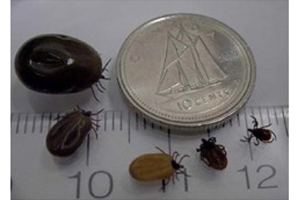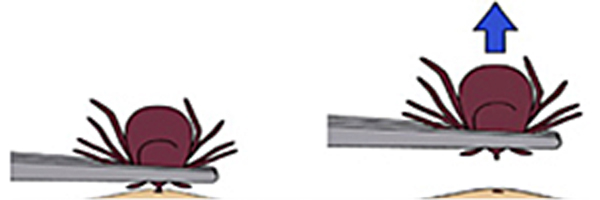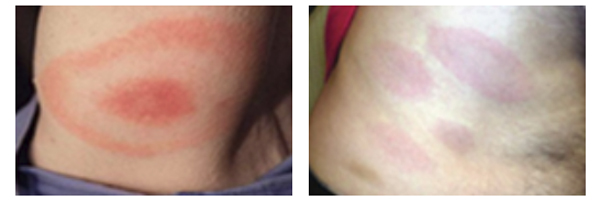Blacklegged Deer Ticks
-
May transmit Lyme disease (if infected)
-
Are small and hard to see.
-
They attach themselves to humans and animals and feed on their blood.
-
Their bites are usually painless, so you may not know that you have been bitten.
They can range in size depending on how long they have been feeding.

Adult female blacklegged tick at various stages of feeding. Photo: Government of Canada

Unfed adult blacklegged ticks are about .3 cm long
Do not have a pattern
Adult American dog (wood) ticks are about .5 cm long (which do not transmit lyme disease)
Have a unique pattern
-
As they feed, the tick’s stomach gets bigger. The adult tick can grow from .3cm unfed (about the size of a sesame seed) to 1 cm long when fully fed. Their colours varies by the stage of feeding. From pale brown/yellow to greyish to dark grey-brown when fully fed.
-
Unfed nymphs (young) ticks are about .15cm long when unfed (about the size of a poppy seed) and grow to .3cm when fully fed. Their colour varies from grey-brown when unfed to almost black when fully fed.
Lyme disease
-
Is an infectious disease spread through the bite of infected ticks.
-
Blacklegged tick (or deer tick, Ixodes scapularis) spread Lyme disease in southeastern and south-central regions of Canada.
-
It is not spread by contact with an infected person or animal.
-
Ticks need blood to survive, so they attach themselves on animals and humans to feed.
-
Ticks become infected with Lyme disease bacteria by feeding on infected wild animals, such as:
-
birds
-
rodents
-
-
Once infected, ticks can spread the bacteria to humans and pets, particularly dogs. In most cases, the infected tick must attach and feed for at least 24 hours before the bacteria can be transmitted.
-
Most humans are infected through the bite of immature ticks that are approximately the size of a poppy seed, called nymphs.
-
Adult ticks, approximately the size of a sesame seed, can also spread Lyme disease.
Where are blacklegged ticks found?
-
They are most often found in wooded or forested areas, in leaf litter or on shrubs and tall grass in some parts of Canada.
-
Ticks in at risk areas of southeastern and south-central Canada are more commonly infected.
-
They are spreading to new areas of the province because of climate change.
-
They can also spread by traveling on birds and deer.
-
While the probability is low, it is possible to find an infected tick almost anywhere in Ontario.
Ticks are most active in spring and summer, but can be found at any time of the year when the temperature is above freezing.
High risk areas:
-
If you live, work in, or visit a wooded area, or an area with tall grasses and bushes (including city gardens and parks).
-
If you are involved in outdoor activities such as hiking, camping and gardening.
How to avoid getting a tick bite
1. Cover up
Wear:
-
light-coloured clothing, so it’s easier to see ticks
-
closed-toed shoes
-
long-sleeved shirts
-
long pants, tucked into your socks
2. Use insect repellent
-
Use an insect repellent, or bug spray, that says “DEET” or “icaridin” on it.
-
Put it on your clothes and exposed skin.
-
Always read the label for directions on how to use it.
3. Put clothes in the dryer
-
Kill any ticks that might be on your clothing by putting your clothes in a dryer on high heat for at least 10 minutes before washing them.
4. Check yourself and your children
After being outdoors, check for ticks on yourself and your children.
Look from the top down:
-
head and hair
-
in and around the ears
-
under the arms
-
back (use a mirror or ask for help)
-
waist
-
belly button
-
around the groin
-
legs
-
behind the knees
-
between the toes
Feel for bumps and look for tiny dark spots. Look carefully, most ticks are very small!
5. It’s a good idea to have a shower as soon as you can to wash off any ticks.
6. Check your pets for ticks
-
After being outdoors, check your pets’ skin and remove any ticks you find.
-
Ask your veterinarian about options to help keep ticks off your pets.
7. Maintain your property
You can help keep blacklegged ticks away from your property by:
-
keeping grass mowed short
-
trimming bushes and tree branches to let in sunlight (ticks avoid hot, dry locations)
-
creating a border of gravel or woodchips one metre or wider around your yard if you’re next to a wooded area, or an area with tall grasses
-
removing leaf litter, brush and weeds at the edge of the lawn and from stone walls and wood piles
-
moving children’s swing sets, playground equipment and sandboxes away from wooded areas
-
consider placing equipment on a woodchip or mulch foundation
How to remove a tick
-
Removing ticks within 24-36 hours after the tick bite usually prevents infection.
-
Removing a tick is the same for humans and animals.
-
It’s important you do not crush or damage the tick because it could cause Lyme bacteria to pass from the tick into your bloodstream.
-
If the mouthparts break off and remain in the skin, remove them with tweezers or, if you are unable to remove them easily, leave them alone and let the skin heal. Consult your healthcare provider.
1. Use clean fine-tipped tweezers and grasp the tick as close to your skin as possible.
-
Do not use a lit match or cigarette, nail polish or nail polish remover, petroleum jelly (e.g., Vaseline), liquid soap or kerosene to remove the tick.
2. Pull the tick straight out, gently but firmly.
-
Do not jerk or twist the tweezers while pulling the tick out.
-
Do not squeeze the tick – you might crush it.
 2
23. Once you have removed a tick, wash your skin with soap and water and then disinfect your skin and your hands with rubbing alcohol or an iodine swab.2
4. Put the tick in a secure container (for example, a bottle with a screw top so it can’t get out or be crushed) and record the date of the bite. 2
5. Consult your health care provider as soon as possible if:
-
you are not comfortable with removing a tick
-
you cannot remove the tick because it has buried itself deep into your skin
-
If you develop symptoms of Lyme disease after being bitten by a tick
-
if you visited a known at risk area for Lyme disease.
6. The earlier a diagnosis is made, the greater the chance of a successful treatment.
7. Bring the bagged tick with you to your medical appointment as it may help the doctor in their assessment of your illness.
8. Contact your local public health unit. Tell them:
-
how long you think the tick was attached to you
-
and where you were when you were bitten by the tick
9. Ticks can be disposed of in household garbage once they are dead, and they can be killed by drowning them in rubbing alcohol or by freezing for several hours. Avoid squashing ticks with exposed fingers.
Why ticks are tested
-
Tick testing is used to monitor where ticks live. This is why it’s important that you contact your local public health unit once you have a tick in a secure container. If appropriate, they will send it to the Public Health Ontario Laboratory for identification and possibly test if for Lyme disease.
-
Tick testing is not used to diagnose Lyme disease in humans.
Lyme disease signs and symptoms
-
Early symptoms of Lyme disease in humans usually appear between three and 30 days after a bite from an infected blacklegged tick.
-
Symptoms of Lyme disease can be different from person to person.
-
Most people experience mild flu-like symptoms soon after being bitten, while a small number may have more serious symptoms, sometimes weeks after the bite.
-
You should contact your local public health unit or speak to a health care professional right away if you have been somewhere that ticks might live and experience any of the following symptoms:
- Rash
-
a bull’s-eye rash (a red patch on the skin that is usually round or oval and more than 5 cm that spreads outwards and is getting bigger3
-
a bruise-like rash (usually on darker skin tones)3
-
another type of unusual rash3
 3
3-fever
-chills
-headache
-stiff neck
-muscle aches and joint pains
-fatigue (more tired than usual)
-swollen lymph nodes
-spasms, numbness or tingling
If not treated, Lyme disease can make you feel tired and weak and, if it gets really bad, it can even harm your heart, nerves, liver and joints. 3
Severe symptoms may include:
-
Severe headaches
-
Additional EM skin rashes
-
Facial paralysis (i.e. Bell's palsy)
-
Intermittent muscle, joint, tendon and bone aches
-
Heart disorders (heart palpitations, abnormal heartbeat), known as Lyme carditis
-
Neurological disorders (dizziness, mental confusion or inability to think clearly, and memory loss, inflammation of the brain and spinal cord, nerve pain, numbness or tingling in the hands or feet)
-
In rare cases, Lyme disease can lead to death usually because of complications involving infection of the heart.
Lyme disease treatment
-
Your healthcare provider may diagnose you with Lyme disease depending on your signs, symptoms and risk factors.
-
Most cases of Lyme disease can be effectively treated with 2 to 4 weeks of antibiotics.
-
Depending on the symptoms and when you were diagnosed, you may require a longer course or repeat treatment with antibiotics.
Post-treatment symptoms
You may experience symptoms that last months to years after treatment. This is a condition known as post-treatment Lyme disease syndrome (PTLDS).
Symptoms of PTLDS can include:
-
Sleep disturbance
-
Fatigue (tiredness)
-
Muscle and joint pain
-
Mental confusion or inability to think clearly, with subtle cognitive changes
Research continues into the causes of these persistent symptoms and possible treatment methods
Treating Lyme disease while pregnant
-
Treatment for pregnant women with Lyme disease is similar to that of non-pregnant adults. However, certain antibiotics, such as doxycycline should not be used as it can affect your unborn child.
-
Research shows that there are no life-threatening effects on the child when a pregnant woman receives appropriate antibiotic treatment for Lyme disease.
For more pest control tips:
Sources:
Answer to social media question:
Where can blacklegged deer ticks be found?
1-wooded areas
2-your backyard
3-both
Answer 3 -While deer ticks are generally found in wooded areas they can also be spread by traveling on birds. Therefore balcklegged deer ticks can be found anywhere in Ontario including your back yard.




Post a comment